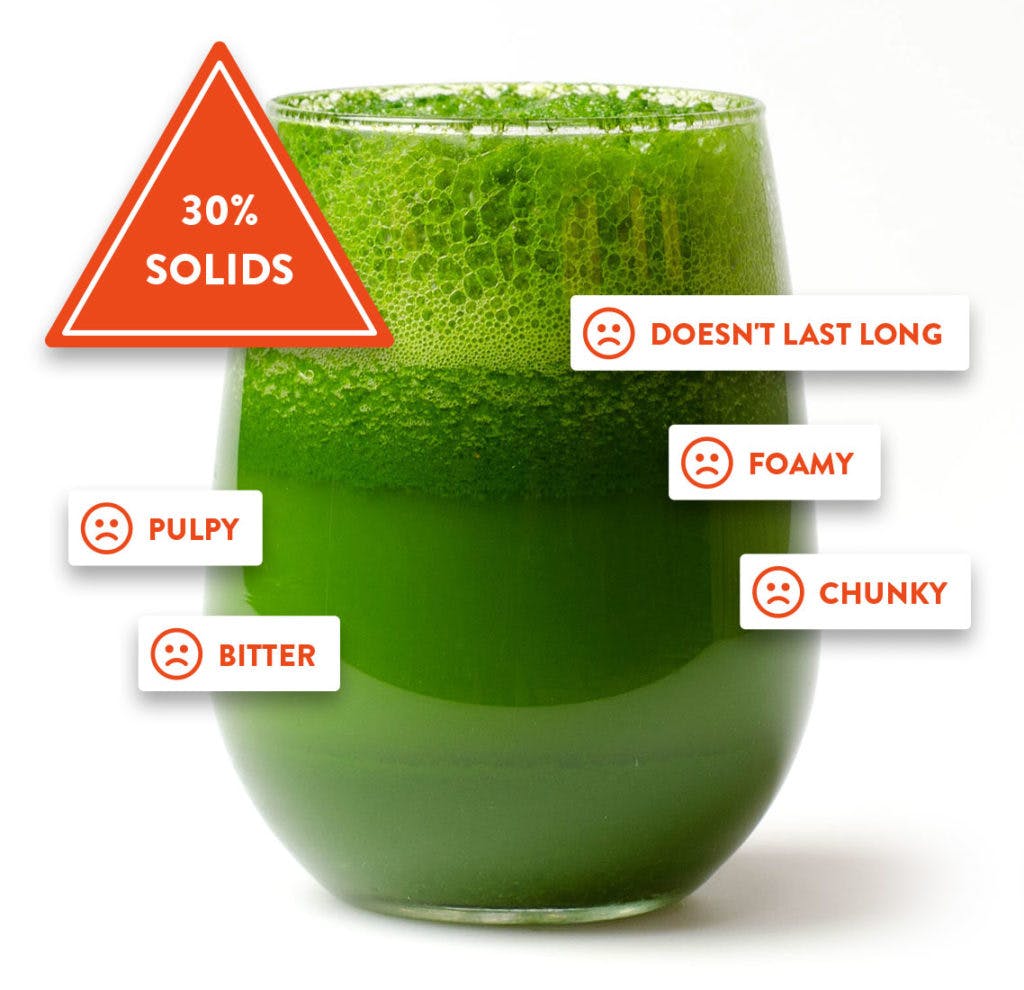A masticating juicer works by slowly crushing and squeezing fruits and vegetables to extract the juice. Masticating juicers use a single or twin gear system, which rotates at a low speed to separate the juice from the pulp.
This process retains more nutrients, enzymes, and fiber in the juice, resulting in a higher quality and more nutritious drink. Masticating juicers are also capable of processing leafy greens and wheatgrass, making them versatile for different juicing needs. Their gentle and efficient method of juicing produces minimal heat, minimizing oxidation and allowing the juice to be stored for longer periods without significant loss of quality or nutrients.
This makes masticating juicers a popular choice for health-conscious individuals seeking the best possible juice extraction.

Credit: www.goodnature.com
What Is A Masticating Juicer?
A masticating juicer is a type of juicing machine that operates by slowly grinding and squeezing fruits and vegetables to extract their juice. It is designed to mimic the process of chewing, hence the name “masticating. ” This juicer uses a single auger, or gear, to crush the produce and separate the juice from the pulp.
It operates at a low speed, usually around 80 to 100 rpms, which helps to minimize oxidation and heat build-up, preserving the nutrients and enzymes in the juice. The process is relatively quiet and produces a high yield of juice with little to no foam.
Masticating juicers are known for their versatility, as they can handle a wide range of produce, including leafy greens and wheatgrass. In addition to juicing, many masticating juicers also have other functions, such as making nut butters, baby food, and sorbets.
Using a masticating juicer can offer several benefits, including higher nutrient retention, longer shelf life of the juice, and better extraction of juice from leafy greens.
The Functioning Of A Masticating Juicer
A masticating juicer operates by utilizing a slow and gentle squeezing action to extract juice from fruits and vegetables. This method involves a two-step process. Firstly, the produce is crushed and ground into a pulp using a rotating auger or gear.
Secondly, the pulp is pressed against a mesh screen or filter to separate the juice from the fiber. This technique allows the juicer to preserve the nutrients, enzymes, and vitamins of the fruits and vegetables, resulting in a more nutritious juice with minimal oxidation.
Masticating juicers also have the ability to handle leafy greens and wheatgrass effectively, making them a popular choice for health-conscious individuals and juicing enthusiasts. Overall, the masticating juicer’s functioning provides a slow and thorough juicing process that ensures maximum extraction and nutrition.
Advantages Of Masticating Juicers
Masticating juicers have several advantages, including enhanced flavor and taste of the juices produced. These juicers are able to retain maximum nutrition from the ingredients. With their slow and gentle squeezing mechanism, masticating juicers extract juice without generating heat, which helps to preserve the nutrients.
The juices made by these juicers are not only healthier but also taste better due to the minimal oxidation and heat involved in the process. Moreover, masticating juicers can juice a variety of ingredients, including leafy greens, wheatgrass, and even nuts.
This versatility allows you to create a wide range of nutritious and delicious juices. So, if you want to enjoy delicious, nutrient-rich juices, a masticating juicer is a perfect choice for you.
Types Of Masticating Juicers
Masticating juicers operate using two main types: single auger and twin gear. Single auger masticating juicers have a spiral-shaped gear that crushes fruits and vegetables against a mesh screen, extracting the juice. This slow, steady process ensures maximum juice yield.
On the other hand, twin gear masticating juicers use two gears with sharp teeth that rotate against each other, effectively grinding the produce into fine particles. This method is particularly efficient for extracting juice from leafy greens and wheatgrass. Both types of masticating juicers work through a gentle and thorough process that preserves the nutrients in the juice while minimizing oxidation.
By understanding the different types and their mechanisms, you can choose the best masticating juicer for your needs.
Key Components Of A Masticating Juicer
A masticating juicer operates through key components that play specific roles. The auger, the primary component, effectively grinds and extracts juice from ingredients. Another vital part is the strainer, responsible for separating the pulp from the juice. The motor powers the entire juicing process, keeping it running smoothly.
Lastly, the hopper is where you insert the ingredients to be juiced. Together, these components work in harmony to ensure that the masticating juicer functions efficiently and delivers high-quality juice. Whether you are seeking a healthier lifestyle or simply enjoy a fresh glass of juice, understanding how a masticating juicer works is essential in making the most out of this powerful kitchen appliance.
So, let’s dive into the inner mechanisms that make it all happen.
Step-By-Step Process Of Juicing With A Masticating Juicer
A masticating juicer operates by following a step-by-step process. First, the ingredients are prepared accordingly. Then, they are inserted into the hopper of the juicer. The juicer extracts juice from the ingredients at a slow and steady pace. Finally, the juice is collected separately from the pulp.
Masticating Juicer Maintenance And Cleaning Tips
Masticating juicers work by slowly crushing and grinding fruits and vegetables to extract the juice. To keep your juicer running smoothly, proper maintenance and cleaning are essential. When cleaning the parts, ensure that you disassemble them correctly to avoid any damage.
Additionally, if there is stubborn residue, try soaking the parts in warm soapy water or using a brush to scrub them clean. After cleaning, make sure to dry all the parts thoroughly to prevent mold or bacteria growth. Finally, store your juicer in a cool and dry place to maintain its optimal condition.
Taking these steps will not only extend the lifespan of your masticating juicer but also ensure that you enjoy fresh and healthy juices every time you use it.
Factors To Consider When Purchasing A Masticating Juicer
Factors to consider when purchasing a masticating juicer include budget considerations, noise level, versatility and juicing capabilities, as well as ease of cleaning and maintenance. In terms of budget, it is important to find a juicer that fits within your price range while still offering the features you desire.
Additionally, considering the noise level of the juicer is crucial, as some models can be quite loud and disruptive. When it comes to versatility and juicing capabilities, it is essential to choose a juicer that can handle a variety of fruits and vegetables, ensuring you can make a wide range of juices.
Finally, ease of cleaning and maintenance should not be overlooked, as a juicer that is difficult to clean may become tedious to use in the long run. By taking these factors into account, you can make an informed decision when purchasing a masticating juicer.
Frequently Asked Questions About Masticating Juicers
Masticating juicers extract juice from fruits and vegetables by slowly crushing and grinding them. They use an auger or a screw-like mechanism to press the ingredients against a strainer or screen. This gentle process helps to retain the maximum nutrients, flavor, and enzymes in the juice.
Leafy greens can be easily juiced in a masticating juicer due to its slow and powerful operation. One of the advantages of masticating juicers is that they produce a higher yield of juice compared to other types of juicers. This means you get more juice from the same amount of ingredients.
While masticating juicers are suitable for home use, they can also be used commercially, but the cost and size of commercial-grade masticating juicers may be a consideration for businesses.
Conclusion And Final Thoughts
Masticating juicers operate by slowly crushing and grinding produce to extract juice. This method preserves the nutrients, flavors, and enzymes, resulting in a higher quality juice. The benefits of masticating juicers include increased juice yield, efficient extraction, minimal oxidation, and extended shelf life.
These juicers can process a wide variety of fruits, vegetables, leafy greens, and even nuts and soy. Additionally, they can be used to make nut butter, baby food, sorbets, and more. Before purchasing a masticating juicer, consider factors such as price, ease of cleaning, noise level, and warranty.
It’s also essential to identify your juicing needs and preferences to ensure you choose the right model. A masticating juicer is a fantastic investment for those seeking nutrient-rich, flavorful juices that support a healthy lifestyle.
Frequently Asked Questions Of How Does A Masticating Juicer Work
What Are The Disadvantages Of A Masticating Juicer?
Masticating juicers have a few disadvantages. Firstly, they are slower than centrifugal juicers, as they operate at a lower speed to extract juice. Secondly, they have a narrower feeding chute, which requires more prep time to cut fruits and vegetables into smaller pieces.
Additionally, masticating juicers are typically heavier and larger, taking up more counter space in the kitchen. Cleaning can also be a bit more time-consuming, as the various parts require disassembling and hand-washing. Another disadvantage is that due to the slow speed of mastication, the juice may oxidize faster, leading to a shorter shelf life compared to juice made with a centrifugal juicer.
Despite these drawbacks, masticating juicers offer superior nutritional value and juice quality, making them popular among health-conscious individuals.
What Is The Difference Between A Masticating Juicer And A Regular Juicer?
A masticating juicer and a regular juicer differ in their operating mechanism. A regular juicer uses centrifugal force to extract juice by spinning at high speeds, while a masticating juicer employs a slow and grinding motion to squeeze out juice from fruits and vegetables.
The masticating juicer’s slower speed prevents heat build-up, oxidation, and damage to nutrients, resulting in a higher quality juice that retains more vitamins and enzymes. Moreover, the masticating juicer can extract juice from leafy greens and wheatgrass more effectively than a regular juicer.
It also produces less foam, has a higher yield, and operates more quietly. In contrast, a regular juicer is faster, making it suitable for quick juicing. However, it may not be as efficient in extracting juice from certain produce types and may have a higher heat generation, potentially affecting the juice’s nutritional value.
Why Is Masticating Juicer Better?
The masticating juicer is better because it operates at a slow speed, which retains more nutrients in the juice. It also effectively extracts juice from leafy greens and wheatgrass. The slower speed prevents oxidation and heat buildup, resulting in a higher quality juice that stays fresh for longer periods.
Moreover, the masticating juicer produces less foam and preserves the natural color and taste of the fruits and vegetables. Its powerful auger works well with both hard and soft produce, ensuring maximum extraction with minimal wastage. Additionally, the masticating juicer can also be used to make other healthy treats like nut butter and sorbets.
Its quiet operation and ease of cleaning make it a convenient choice for juicing enthusiasts. With its superior functionality and nutritional benefits, the masticating juicer is an excellent investment for those seeking an efficient and healthy juicing experience.
Which Juicer Is Better Centrifugal Or Masticating?
Centrifugal juicers are better for quickly processing large quantities of fruits and vegetables. They operate at high speeds, making them ideal for those looking for convenience and time-saving. However, they produce higher heat and oxidation, resulting in a lower quality and shorter shelf life of the juice.
On the other hand, masticating juicers are slower but provide a superior quality juice. They operate at low speeds, minimizing heat and oxidation, preserving nutrients and enzymes. Masticating juicers can handle leafy greens and wheatgrass better than centrifugal juicers and are quieter in operation.
They are suitable for individuals seeking maximum nutritional benefits and longer-lasting juice. Ultimately, the choice between centrifugal and masticating juicers depends on individual preferences, time constraints, and desired juice quality.
Conclusion
Masticating juicers have revolutionized the way we consume fruits and vegetables by extracting the maximum amount of nutrients from them. The slow rotation of the auger gently crushes the produce, releasing every drop of juice and preserving the vital enzymes and vitamins.
Unlike centrifugal juicers, masticating juicers operate at a low speed, reducing oxidation and heat generation, ensuring the juice retains its nutritional value and taste for longer. The advanced technology used in these juicers not only provides us with healthier and more flavorful juice but also enables us to extract juice from a wider variety of ingredients, including leafy greens and wheatgrass.
Moreover, their ability to handle a variety of tasks, such as making nut butter, baby food, and sorbets, makes them a versatile addition to any kitchen. If you are looking for an efficient and nutritious way to enjoy juice, a masticating juicer is definitely worth considering.
Your health will thank you!

Freda is a passionate foodie and kitchen gadget enthusiast. With over 10 years of experience in the culinary industry, Freda brings her expertise in testing and reviewing kitchen gadgets.




